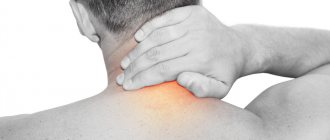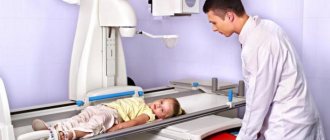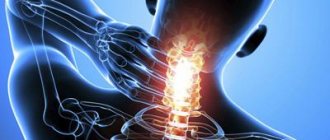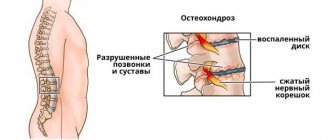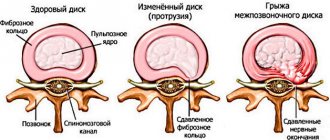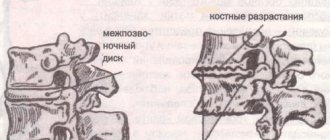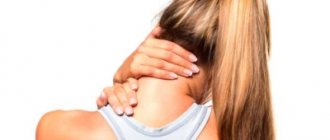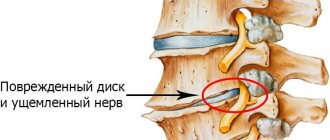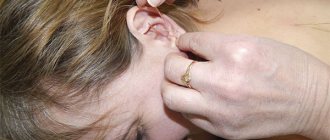The key components of a program for patients to actively participate in the treatment of osteochondrosis can be identified:
- The first step is to quickly reduce the pain to an acceptable level.
- Participate in supervised exercise and active rehabilitation.
- Identify and modify both behavioral and physical activities needed to minimize impact on intervertebral discs.
- Improved hydration and nutrition, which will help improve the condition of the intervertebral discs.
Main symptoms of the disease
The main symptom of the disease is severe pain, due to which a person experiences fatigue.
The pain can be shooting, sharp, aching, of varying degrees of intensity. Common symptoms of osteochondrosis are: dry skin, sweating, cold extremities, numbness, dizziness, weakness. Depending on which part of the spine the disease progresses, others may be added to these signs. Among them, the most common ones are:
- headache;
- feeling of heaviness in the chest;
- decreased concentration;
- pain when turning the body;
- tingling in different parts of the body;
- memory problems.
With osteochondrosis of the spine, there may be pain when inhaling and discomfort in the area of the shoulder blades. In some cases, with osteochondrosis, patients complain of problems and functioning of the genitourinary system and intestines.
What the patient should know about pain due to osteochondrosis
It should be noted that many patients do not know that pain due to degenerative changes in the intervertebral discs (osteochondrosis) in the vast majority of cases can be well treated both with the help of independent measures and some methods of conservative treatment.
Here are a few facts about the nature of osteochondrosis that will help patients navigate treatment options and play an active role in minimizing pain:
- Pain due to osteochondrosis (degenerative changes in the discs) does not progress with age. While intervertebral discs will continue to degenerate, the pain associated with this process will tend to decrease. As a rule, by the age of 60 years, the process of disc degeneration stabilizes and, most often, does not cause pain.
- A characteristic feature of the symptoms of osteochondrosis is that the pain increases significantly during an exacerbation, which can last several days, weeks or even several months, but then, as a rule, the intensity of the pain decreases to a more acceptable level.
- Most often, in case of osteochondrosis, an operation is performed with fixation of the vertebrae (spondylodesis), which is a serious operation and changes the anatomy of the spine by turning the motion segment into one large bone.
Therefore, the primary concern for patients living with osteochondrosis should be to do everything possible to actively manage flare-ups and reduce both the frequency and severity of flare-ups. This attention to the spine, in turn, provides patients with a good chance of maintaining spinal function for daily activities and avoiding major surgery.
Stages of the disease
In medicine, it is customary to distinguish four stages of spinal osteochondrosis:
- Detection of osteochondrosis at this stage, as a rule, occurs by chance during a routine examination. The person feels satisfactorily, in rare cases experiencing slight malaise and rare headaches. The disease proceeds sluggishly, without expressing itself. Therefore, the first symptoms are attributed to normal fatigue after a working day.
- Osteochondrosis at this stage is characterized by the gradual death of cartilage tissue. In this regard, pain syndromes of varying degrees of intensity appear. The sensations intensify when turning the body, bending and other physical activity. A person experiences constant weakness and dizziness.
- For the third stage, the main symptom is severe pain, which cannot always be relieved with painkillers. Changes in the cartilage tissue and spine begin, a hump and scoliosis appear. It is very important to recognize and treat at this stage, otherwise the consequences will be irreversible.
- The fourth stage of osteochondrosis is characterized by difficulty moving and intense pain. This stage is the most dangerous, it leads to disability.
How to sit correctly
The body position should be straight, the back of the seat acts as a support for the spine. Then the pressure on the intervertebral discs will be uniform. If the design of the chair does not provide for this, get yourself a small flat pillow that you will place under your lower back. Make it a rule to stop every 2-3 hours and get out of the cab - move a little, inspect the car. There are several exercises you can do in the parking lot.
A few words about special orthopedic pillows for the back: such a pillow reduces the adverse effects of vibration on the spine, which is forced to maintain a fixed posture for a long time. The right comfort pillow conforms to the shape of your lower back, providing good support for your spine. It helps maintain correct posture, reduce pressure on the lumbar spine and prevent diseases caused by a “sitting” position.
Methods of diagnosis and treatment of osteochondrosis
Treatment of osteochondrosis started in the early stages shows excellent results. Therefore, it is very important not to delay your visit to a specialist and make an appointment at the first sign. To obtain accurate data on the patient’s condition, several laboratory and instrumental studies are prescribed. Among them:
- radiography;
- Ultrasound;
- general blood and urine tests;
- CT scan.
A preliminary anamnesis plays an important role in making a diagnosis. At this stage, it is important to talk about all pain syndromes and discomfort.
Treatment of osteochondrosis and spinal injuries is a combination of several methods. It includes medication, light exercise under medical supervision, hardware, manual techniques and diet.
Medications are selected taking into account individual characteristics and the degree of tissue changes in the spine. The patient is prescribed restorative, painkillers, anti-inflammatory and relaxing drugs. In some cases, when treating osteochondrosis, it is necessary to support the body, so vitamin complexes and various stimulants are added to the above remedies.
When treating the spine, special physical training is of great importance. Therefore, regular exercises are added to the main treatment of osteochondrosis. They help relieve pain, relax muscles, and increase mobility. Sets of exercises are selected by a specialist taking into account tissue changes in the spine. Often massage, acupuncture, mud baths, and therapeutic wraps are added to the main treatment.
Treatment of osteochondrosis without diet is not particularly effective. The diet of a person diagnosed with osteochondrosis should be reviewed by adding foods rich in calcium and protein. These include cottage cheese, cheese and lean fish, beans, nuts and seafood. Pay close attention to cereals, vegetables and herbs.
Osteochondrosis: the answer to an important question
Commented by Joseph Mikhnevich , head of the 1st neurological department of the 5th city clinical hospital of Minsk, candidate of medical sciences. Sci.
Does osteochondrosis affect life expectancy? No, but it reduces its quality.
What happens if the disease is not treated? Loss of ability to work (disability) will occur.
What are the modern principles of treatment of osteochondrosis? Nowadays medications and physical methods are used more rationally. For treatment to be successful, the leading causative factor must first be clarified: what exactly happened in the spine? Do you have a disc herniation or vertebral instability, spondyloarthrosis, spondylosis, circulatory disorders, venous stasis? The doctor must definitely find out the main mechanism of the manifestations: swelling, myofixation (local, widespread, involving the muscles of neighboring regions). Study neurodystrophy (when additional tunnel syndromes, myofascial pain zones and trigger points develop). Only influencing the main links will give a good result.
Are there new drugs for osteochondrosis? Each group of medications used in the treatment of osteochondrosis contains modern ones. Thus, among the most commonly used non-steroidal anti-inflammatory drugs (NSAIDs), there appeared those that block only the inflammatory enzyme - selective COX-2 inhibitors. They are devoid of the main side effect of NSAIDs - damage to the mucous membrane of the digestive organs.
There are also new products in the group of decongestants, venotonics and muscle relaxants.
Will osteochondrosis interfere with pregnancy? If a woman does not prepare for bearing a child, osteochondrosis will interfere. To exclude manifestations of the disease during this period, the expectant mother must strengthen her muscle corset in advance. This is facilitated by swimming, therapeutic exercises and walking. There is no need to give up light exercise during pregnancy (of course, taking into account the recommendations of your obstetrician-gynecologist).
Is it necessary to treat osteochondrosis in old age? Necessarily. But the doctor should take into account concomitant diseases, and in old age there is a whole bunch of them. For example, osteoporosis most often develops, especially in women. This is a much more serious damage to the skeletal system, when fractures of the vertebral bodies and femoral neck occur. And many medications and techniques used for osteochondrosis (corticosteroids, intense massage, manual therapy, spinal traction, active gymnastics) only intensify the manifestation of osteoporosis.
What vitamins - synthesized or natural - do the body need in the first place for osteochondrosis? For prevention, the entire complex of vitamins and microelements is necessary; the best are those that come with food. But if the content of natural vitamins in products decreases, for example, in the winter-spring period, you need to take a course from the pharmacy.
Can this disease paralyze a person? Unfortunately yes. Due to compression (squeezing) of the spinal cord or nerve roots, osteochondrosis can cause paralysis.
With osteochondrosis, is it possible to do the “corner” exercise on the wall bars and do pull-ups? Is simply “hanging” on a bar useful? No, this will make things worse.
Are stretching exercises harmful to the spine, namely bending back and forth left and right at a slow pace? They are allowed only in the initial stage of osteochondrosis.
Is the disease inherited? Our ancestors give us a predisposition to the development of osteochondrosis. But this does not mean that the disease is inevitable.
What is preferable in case of osteochondrosis: to protect yourself, strive to be warm - or to harden yourself? You should always dress according to the weather.
Overheating will cause sweating; along with sweat, the body will lose essential salts and vitamins; muscle tone will decrease, diuresis will decrease, blood viscosity will increase, as a result, homeostasis will be disrupted, which will also damage the spine.
Hypothermia spasms blood vessels, strains muscles, which forms myofascial pain syndromes and contributes to the occurrence of arthritis of the intervertebral joints.
Is it possible to cure osteochondrosis? It is only possible to stop its clinical (neurological) manifestations, and even then not always. The best treatment is prevention:
- exclusion of static and dynamic overloads;
- compliance with ergonomic rules when working;
- correct position during work, sleep and rest.
I have osteochondrosis. I decided to run in the morning. I bought special sneakers. So far there are no unpleasant sensations in the back. But I’m worried whether these activities will worsen my condition? It's not worth the risk. The best sports for the prevention of osteochondrosis are walking at a fast pace and swimming. The first allows you to better control muscle load, maintain posture, shocks and vibration are eliminated, and more muscles are involved. Water evenly distributes the load on the muscles of a swimming person, coordinates their work, there are no rough or sudden movements, blood circulation and metabolism are stimulated.
Other means include regular sex. Various muscle groups work (legs, buttocks, abdomen, arms, back) - in combination with the release of hormones and positive emotions. Blood circulation improves and venous congestion in the pelvis and lumbar spine decreases.
Will diet help slow down spinal degeneration; what products do you prefer? A healthy diet includes lactic acid products, fish, vegetables and fruits - sources of calcium and phosphorus, magnesium, manganese, zinc and vitamin D. I advise you to limit sugar, salt, fats, smoked foods: they disrupt the metabolism in the body, in which case the spine does not receive the necessary nutrients.
Read in full: https://www.medvestnik.by/ru/zdorov-voprosy/view/osteoxondroz-otvet-na-vazhnyj-vopros-15268-2016/
Factors in the development of osteochondrosis and consequences
The exact reasons that contribute to the development of osteochondrosis have not yet been precisely established. The first signs usually appear after 30–35 years. The main factors for the development of spinal osteochondrosis include:
- sedentary lifestyle;
- hard physical labor;
- regular lifting of weights;
- long work in a sitting position.
Other factors leading to osteochondrosis include injuries and inflammatory processes in the spine, hereditary diseases leading to deformation of the spinal column, incorrect posture, and infectious diseases. The following moments are also favorable for the development of the disease: a sudden cessation of sports or, on the contrary, an excessively fast start, excess weight, poor nutrition, poor environment, long-term use of medications.
The main risk groups predisposed to osteochondrosis include people in the following professions: drivers, office workers, builders, athletes, loaders.
Control of osteochondrosis:
Osteochondrosis makes life quite difficult. However, osteochondrosis should not interfere with the rest of your life.
Here are three things a patient can do to control spinal disc degeneration:
Step One: Be Active to Slow Disc Degeneration
Once the pain is properly controlled (the pain will likely not go away completely), the most important thing patients can do is stay active.
Not only can exercise maintain what is already functioning; they are the best way to treat the spine. Exercise increases the flow of blood and oxygen and other nutrients into the spine and discs, thereby keeping them hydrated and elastic to varying degrees. Exercise can also improve a patient's well-being by increasing the production of endorphins, the body's own analgesics and anti-stress substances.
In order to stay active, you don’t need a lot of investment, but you need clear planning of loads: Aerobic and strength training
Alternating 30 minutes of strength training with low-impact exercise such as walking, cycling or swimming every other day can help maintain flexibility and mobility and help control weight. For those whose strength training leads to pain, a more careful approach is needed. Swimming is most optimal for them, since in water the load on the spine decreases. Stretching
Just 5 minutes of stretching in the morning after sleep and 5 minutes before bed significantly increases the mobility of the motor segments of the spine. It is also useful to stretch the thigh muscles for lower back pain. If you have piriformis syndrome, special stretching exercises may be recommended.
It is advisable to select all exercises with a physical therapy doctor (instructor) in order to avoid incorrect execution of exercises, which can lead to increased pain.
Preventive measures
A person is very busy at work and often neglects to consult a doctor in a timely manner. However, for those who ignore the disease, it is important to understand: the consequences of untreated osteochondrosis are quite serious. Incorrect body position affects the functioning of the lungs and heart. Women may experience problems with the reproductive system, including infertility. A person can live with osteochondrosis, but the quality of life will sharply decrease. Preventing the disease is quite simple, because pathology does not develop instantly. From an early age, you should monitor your body position, do not slouch, sleep on hard surfaces, and do not lift heavy objects. We also strongly recommend giving up bad habits, balancing your diet, and remembering to stretch after being in one position for a long time. At the first sign, make an appointment with specialists from the MEDCOM network of clinics.
Osteochondrosis “at the wheel”
The consequences of prolonged driving can be not only pain in the back and neck, but also chronic diseases of the spine. According to the results of a study conducted by the RAC - the British Royal Automobile Society - it became known that the majority of drivers sit for a long time in the wrong position, the result is overstrain of the back muscles. The “banana pose” has a particularly negative impact on health - when the driver has straightened legs extended towards the pedals, and the body is tilted towards the steering wheel.
The pressure on the intervertebral discs is maximum, and shaking during driving increases it even more. The likelihood of serious injury during accidents also increases. According to doctors, it is better to use hard seats in trucks that are well adjusted to the driver’s figure. As for the material used to make the seat upholstery, it is better if it is fabric rather than leather or vinyl. The driver should not move too far away from the pedals. And the headrest should be carefully adjusted.
Freight transport drivers who spend long periods of time behind the wheel do not pay due attention to the prevention of spinal diseases, and this is the main cause of the problem.
Meanwhile, osteochondrosis can be classified as an occupational disease of drivers. And in preserving the driver’s health, a huge role belongs to the choice of truck - taking into account not only its driving performance, but also the ergonomics of the cabin.
Transcript of the audio recording “School for a Healthy Spine”
Hello, dear listeners. Our conversation is intended for people who are attentive to their health. A person’s desire for perfection is worthy of respect, because being healthy and successful is not only fashionable, but useful and profitable. But how can you become successful if your health has deteriorated and you don’t have the strength to continue on your intended path in life because of back problems? You need to learn how to maintain a healthy spine and resist osteochondrosis. It is now known that acute back pain is the most common cause of disability in people under 45 years of age. At the age of 45 to 65 years, pain in the lower back and neck ranks third in frequency after heart and joint diseases (arthritis). It was found that 60-80% of the population experienced such pain at least once.
Foreign scientists have calculated that low back pain syndrome ranks third (as the most expensive disease after heart disease and oncology), because it is associated with significant costs for diagnosis and treatment, operations, disability compensation and disability subsidies.
Causing disability in people of the most active age from 30 to 50 years, osteochondrosis significantly reduces their quality of life, darkening the joy of existence.
The clinical manifestations of spinal osteochondrosis are so diverse and multifaceted that they are sometimes disguised as diseases that are far from each other. The most famous and common syndrome of osteochondrosis is pain in the back, neck, lower back, shoulder and pelvic girdle. A significant portion of the adult population experiences them periodically. Currently, this disease is as common as influenza and cardiovascular diseases, and is not inferior to them in terms of financial costs of treatment.
How to prevent spinal osteochondrosis? The path is enlightened knowledge, self-education in health matters and the formation of a correct lifestyle. Let's change life for the better and combine the wisdom of age with the possibilities of youth! Let's start learning.
